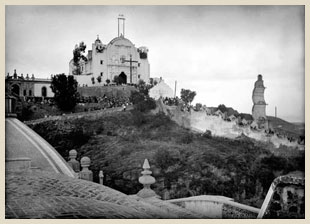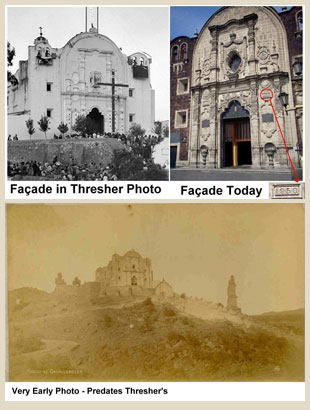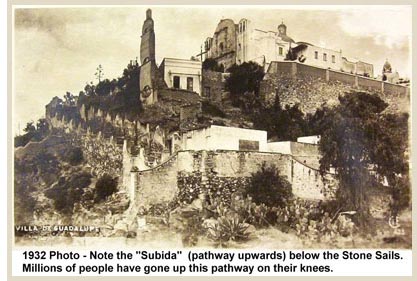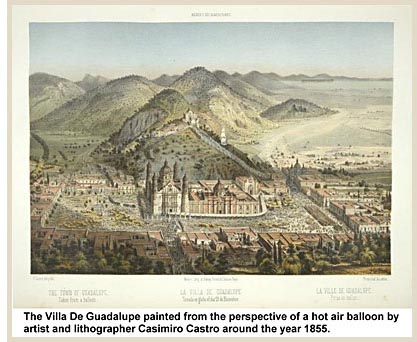 |
Malcolm Lubliner ~ Photography & Art Since 1965 |
| Historic Mexico | About Historic Mexico | Photographs Page 1 | Photographs Page 2 |
“Church
on the Hill" |
|||||
The setting for story of the photo "Church on the Hill" is the site of the famous Mexican shrine of "Nuestra Señora de Guadalupe" (Our Lady of Guadalupe), also called "La Virgen de Guadalupe". This shrine is a symbol of significant importance to Catholics, especially Mexican Catholics. The Virgin Mary as she appeared there has been given the title "Patroness of the Americas", and the Basilica of Our Lady of Guadalupe in Mexico City is the second most visited Catholic shrine in the world. The Blessed Virgin appeared on a hilltop called Tepeyac on the outskirts of Mexico City to Juan Diego Cuauhtlatoatzin, a poor Indian, on December 9th, 10th and 12th, of the year 1531. She left a miraculous image of her appearance on his cactus fiber cloak, or "tilma", which still exists today for all to see in the Basilica of Our Lady of Guadalupe which is near the church that Thresher shows in his photo. As a matter of fact it looks like Mr. Thresher took his photograph from the roof of the Old Basilica. The church in the photograph is commonly called "La Capilla del Cerrito" in Spanish which means "The Chapel on the Little Hill". The tall item to the right of the church that looks like the mast and sails of a ship is exactly that only the sails are made of stone. It is known as "Las Velas del Marino" (The Sails of the Seafarer) and is sometimes just referred to as Las Velas de Piedra (The Stone Sails). At the time the photo was taken there were seven main elements to the Guadalupe Shrine. The Capilla del Cerrito and Velas del Marino I have already mentioned. In addition there were the Basilica Antigua (Old Basilica), Convento de Capuchinas (Convent of Franciscan Nuns), Antigua Parroquia de Indios (Old Church of the Indians), Capilla del Pocito, and the Panteón (Cemetery). I won't go into detail about all of these items except to note that they are all part of the Virgen de Guadalupe pilgrimage experience. The Capilla del Cerrito was built on the spot where Juan Diego first saw the Virgin Mary. It was originally built in 1666 by a Mexico City baker named Cristóbal de Aguirre and his wife Teresa Pelegrina. It was just a small chapel and was rebuilt much larger in 1749. In the front and to the sides leading below you can see the path called "Súbida de Tepeyac" or "The going up to Tepeyac". Over the centuries millions of people have gone up this path on their knees. The façade of the second building was not finished until 1950 so there are some differences between the Chapel façade in Thresher's photo and the Chapel façade of today. You can see this in a comparison photo that I made below.
The following excerpt is from a book written by Colonel Albert S. Evans published in 1873 by the Columbian Book Company and entitled "OUR SISTER REPUBLIC: A Gala Trip Through Tropical Mexico in 1869-70". "From the church a winding pathway leads up the steep face of the rocky hill to the chapel on the summit where the Virgin first appeared to Juan Diego. Halfway up the hill is a curious structure of stone, plastered and whitewashed, which represents the sails, mast, and yard of a ship. In fact, the mast of a ship is said to really be built into the masonry. This was erected many years ago by a pious old Spanish rover, who in the hour of mortal peril on the Spanish Main vowed to the Virgin, that if she would enable him to tack, and prevent his galleon going on the rocks, he would do this in her honor; she did it; and he kept his word like a man and a Christian." From "Travels in Mexico and Life Among the Mexicans" by Frederick A Ober published in 1884 by J. Dewing & Company: "On the side of the hill, half-way to the chapel, is a monument in stone and mortar to one man's devotion, in the shape of the mast and sails of a ship. Caught at sea in a storm, a sailor vowed he would build a stone ship to the glory of the Virgin, if allowed to escape to land. Once safe ashore, either his funds or his piety failed him, since he got no farther than the foremast. And there it stands today, the only stone effigy in existence perhaps, of a ship, or part of one, of so large a size."
"At the back of the principal church is a strange stairway, leading to the Chapel on the Hill (Capilla del Cerrito). This ascent is composed of very wide stone steps, of which there are some hundreds, that conduct from the Chapel of the Well containing the sacred water, at the bottom of the hill, to the small church on the top. It is up these steps that devout pilgrims crawl on their hands and knees. There are several little shrines in the walls; but the most curious object of all is the monument known as the Stone Sails. That sails should be composed of stone is indeed a paradox; but such is the case. They stand about 30 or 40 feet high, and are really three sails - one on top of the other - carved in solid stone. They are not particularly picturesque, but the position in which they are placed is so prominent that they can be seen for miles around. The story of these sails, which were a votive offering, is as follows:- Some sailors, who were overtaken by a terrible storm, and on the verge of shipwreck, offered up a prayer to the Lady of Guadalupe for preservation. They vowed that if this miracle was vouchsafed, they would take the mast of their ship and set it up as a votive offering on the hill which is sacred to her memory. The ship and her crew were saved, and the men carried out their promise; but so miraculous was their escape that money was subscribed to erect something of a more lasting nature than a wooden mast, and accordingly these strange looking Stone Sails were put up in token of gratitude, and as evidence of the wonderful power of the Sacred Lady."
"The following day was set aside for fulfilling the vow we made during the tremendous storm. So all those from our ship who had gone ashore, including myself, readied themselves at the pier. From those remaining on board came the chaplain with the captain, pilot, and others carrying the foremast sail with them. We set out barefoot in a procession to the Church of the Divine Shepherdess, where mass was sung by the aforementioned chaplain. After the foresail was deposited, everyone went about their business." The date would have been about right but the problem is that Friar Bergamo said nothing about carrying the foremast sail all the way to Tepeyac in the capital of New Spain. The Stone Sails became quite famous over the years and a model of them was included in the Mexican exhibit at the World's Columbian Exposition in Chicago in 1893. Here is an excerpt from "The Book of the Fair": "Entering the Mexican section near the United States exhibit of vehicles, we are confronted with the typical horseman of our sister republic, with wide sombrero and mounted on a profusely caparisoned steed. Near by are specimens of saddlery and wagon work, both of skillful execution. In one of the corners is a replica of the so-called stone sails near the summit of the hill of Guadalupe, in the neighborhood of which stands the temple of Our Lady of Guadalupe, whither, as the legend runs, a party of shipwrecked sailors, in fulfillment of a vow, bore the foremast of their ship, planting the transformed emblem of their devotion where now it stands. Of this curiosity there is an exact reproduction by the Mexican National railroad, except that it is some twenty feet lower than the original." I have my own theory about the Stone Sails. I believe it is a monument to “Stella Maris”, the “Star of the Sea”. This is an ancient title for the Blessed Virgin, used by seafarers and others associated with the sea. Just as seafarers have traditionally depended on the stars for navigation, so they trust in the protection and guidance of the Blessed Virgin. Pope John Paul II acknowledged the special needs of sailors and immigrants and wrote a "motu proprio" about Stella Maris. A motu proprio (Latin "on his own impulse") is an Apostolic letter issued by the Pope on his own initiative and personally signed by him. Here is an excerpt from that motu propio:
My theory is that many sailors brought votives in the form of sails and pieces of their ship to the Virgen de Guadalupe to give thanks for safe passage. They came from both Veracruz in the East and from Acapulco in the West where the Manila Galleons from the orient trade landed. There was a "land bridge from Acapulco to Veracruz and all of the gold and spices and other trade goods that crossed Mexico back and forth between both places would have passed right by Tepeyac starting about 1565. I think that the Stone Sails were erected by architect Francisco Antonio Guerrero y Torres and his volunteer masons at the same time the Chapel of the Well was built in 1791 in order to consolidate the various votives of the sailors into one great monument to Stella Maris. I am going to maintain that opinion until I encounter reliably documented information to the contrary. Although there was a small Mexican exhibit at the Philadelphia Centennial in 1876, Mexico's attendance at New Orleans constituted the first major effort to portray itself as a modern nation on the world stage. Some people claim that the Kiosco Morisco was used at the Exposición Internacional de París in1889 and the Louisiana Purchase Exposition World's Fair in St. Louis in 1904 but I can find no evidence of this. Mexico did participate in these fairs but the exhibits were larger and completely different. I believe that one of the reasons that people think the Kiosco Morisco was used again in Paris and St. Louis was that flattering promotional material from the New Orleans exhibition was used to create advance promotional material for future fairs. Mexico also participated in the Chicago exhibition of 1893 and the Buffalo exhibition of 1901 but for economic reasons it was on a much smaller scale. Cast iron, the material used for the Kiosco Morisco, was a natural for that time. Cast iron was the metal of choice throughout the second half of the 19th century. Not only was it a fire resistant material but large structures could be produced with cast iron at less cost than other materials such as brick or stone and cast iron structures could be erected with speed and efficiency. Cast iron is also more resistant to corrosion than either wrought iron or steel and while molten, cast iron is easily poured into molds, making it possible to create nearly unlimited decorative and structural forms. For this reason it was particularly useful in creating the intricate design patterns on the Kiosco Morisco. Apparently José Ramón Ibarrola, the designer, was an acquaintance of Andrew Carnegie, the iron and steel magnate. The sections of the Kiosco Morisco were cast at the Union Mills Foundry of the Keystone Bridge Company which was one of Andrew Carnegie's companies. As a matter of fact both Mr. Carnegie and Señor Ibarrola received honorary degrees together in 1906 from the University of Pennsylvania. At the New Orleans Exhibition the Kiosco Morisco (Mexican Alhambra) was situated near the southeast corner of the Main Building. Over the entrance to the Kiosco Morisco hung a prominent sign containing the Mexican national seal and the words, "Mexican Mining Pavilion", in gilded letters. Within the pavilion were large glass display-cases, arranged in two circles, in which were placed a multitude of rare minerals from each of Mexico's mineral States. The States having the finest displays were Sinaloa, Chihuahua, Zacatecas, Guanajuato and Hidalgo, whose immense resources in iron, copper, zinc and lead, as well as in the more precious metals of gold and silver, were well represented. Precious stones were also shown and in particular opals from the state of Queretaro. Beneath the dome, at the center of the pavilion, was a half a ton of silver displayed as a mountain, while collections of various tropical shrubs were placed beneath the colored-glass windows surrounding the building. A distinguished mining engineer and very accomplished individual by the name of Gilberto Crespo y Martínez was in charge of the displays in Mexican exhibit. In addition to the Kiosco Morisco, a wooden building was constructed to house both a Mexican martial band and a cavalry squadron. It was reported that the Kiosco Morisco and the Mexican band were the most popular foreign attractions at the fair. The Kiosco Morisco was declared a National Artistic Monument by the Mexican Instituto Nacional de Antropología e Historia en 1972 and underwent a complete restoration in 2003. It is located at the Alameda de Santa María la Ribera which is bounded by the streets Salvador Díaz Mirón, Dr. Atl, Manuel Carpio, and Torres Bodet, in the Colony of Santa María la Ribera. It is stunningly beautiful and well worth a visit. Bob Mrotek can be reached by e-mail at bob.mrotek@gmail.com or at info@cityvisions.com. |
|||||
| Home | Nature & Human Nature | Automotive Landscape | Artists Portraits | Historic Mexico | Resumé | Contact |


 The thing that I find most fascinating about the Thresher photo
is the Stone Sails. They were constructed at about the same time
that the Capilla del Pocito (Chapel of the Little Well) was constructed
in 1791. This structure covers the well where the Virgin caused water
to spring forth. It will be the subject of my next Thresher photograph.
The story surrounding the Stone Sails usually involves a lost mariner
or mariners who prayed to the Virgin for safety on the storm tossed
ocean and made a vow to carry their mast and foresail to Tepeyac
as a votive to the Virgin of Guadalupe. Various travelers over the
years have written about it and I have included here some of what
they wrote.
The thing that I find most fascinating about the Thresher photo
is the Stone Sails. They were constructed at about the same time
that the Capilla del Pocito (Chapel of the Little Well) was constructed
in 1791. This structure covers the well where the Virgin caused water
to spring forth. It will be the subject of my next Thresher photograph.
The story surrounding the Stone Sails usually involves a lost mariner
or mariners who prayed to the Virgin for safety on the storm tossed
ocean and made a vow to carry their mast and foresail to Tepeyac
as a votive to the Virgin of Guadalupe. Various travelers over the
years have written about it and I have included here some of what
they wrote. From "Mexico as I saw it" by Mrs. Alec Tweedie, published
in London by Thomas Nelson & Sons, 1911:
From "Mexico as I saw it" by Mrs. Alec Tweedie, published
in London by Thomas Nelson & Sons, 1911: I have searched and searched for a record
of who this sailor or sailors might be and then I found a book
written by an Italian Franciscan Friar who journeyed to Mexico
in 1761. The manuscript for this book was sitting in some obscure
library until it was brought to light only recently and translated
into English. It is entitled "Daily
Life in Colonial Mexico - The Journey of Friar Ilarione da Bergamo
1761-1768 (University of Oklahoma Press). Here is an excerpt from
Friar Bergamo's tale:
I have searched and searched for a record
of who this sailor or sailors might be and then I found a book
written by an Italian Franciscan Friar who journeyed to Mexico
in 1761. The manuscript for this book was sitting in some obscure
library until it was brought to light only recently and translated
into English. It is entitled "Daily
Life in Colonial Mexico - The Journey of Friar Ilarione da Bergamo
1761-1768 (University of Oklahoma Press). Here is an excerpt from
Friar Bergamo's tale: "'Star of the Sea' has long been the
favorite title by which seafaring people have called on her in
whose protection they have always trusted: the Blessed Virgin Mary.
Jesus Christ, her Son, accompanied his disciples in their boat,
helped them in their labors and calmed the storms. Thus the Church
also accompanies seamen, taking care of the specific spiritual
needs of those who for various reasons live and work in the maritime
world."
"'Star of the Sea' has long been the
favorite title by which seafaring people have called on her in
whose protection they have always trusted: the Blessed Virgin Mary.
Jesus Christ, her Son, accompanied his disciples in their boat,
helped them in their labors and calmed the storms. Thus the Church
also accompanies seamen, taking care of the specific spiritual
needs of those who for various reasons live and work in the maritime
world."